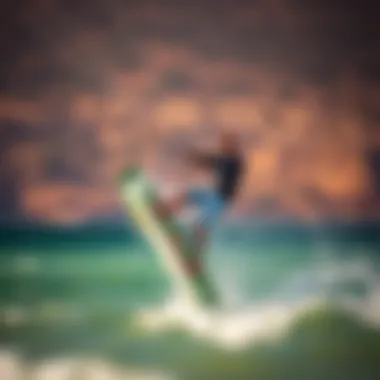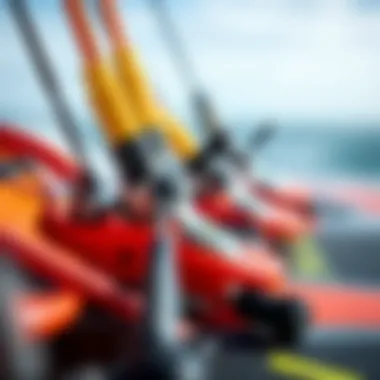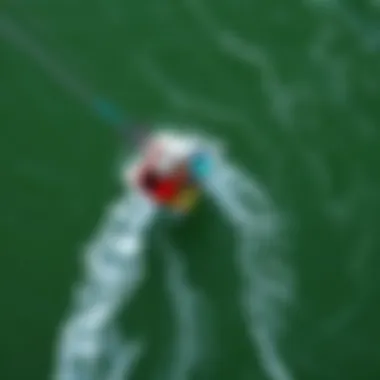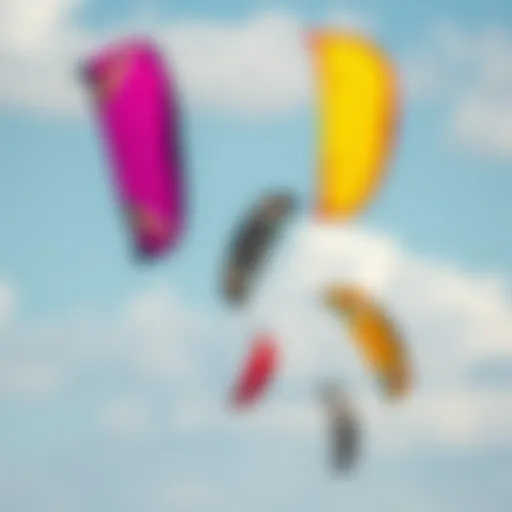Mastering the Flip Tip in Kiteboarding Techniques


Intro
The flip tip is an exciting staple in the repertoire of kiteboarding maneuvers. This technique not only elevates a rider's flair on the water but also showcases their agility and control. For many enthusiasts, mastering the flip tip can feel like a rite of passage, leading to a deeper appreciation of the sport and camaraderie within the kiteboarding community.
Understanding the mechanics behind the flip tip is crucial for both beginners and seasoned riders. The graceful rotation, the timing of kite and board, and the specific body movements all intertwine, allowing riders to execute this maneuver smoothly. Nonetheless, safety should never be sidelined, as the thrill of kiteboarding comes with its set of challenges.
Through this article, we will navigate each aspect of mastering the flip tip, breaking down its significance, necessary gear, and the techniques that will allow riders to incorporate this maneuver into their skill set. By combining expert tips with practical advice, kiteboarders will enhance their prowess on the water, and push their skills to new heights.
Gear and Equipment
Before you can send yourself into the air performing a flip tip, it’s essential to have the right equipment. Riding with the right gear enhances performance and maximizes safety.
Essential Kiteboarding Gear: A Comprehensive Guide
When selecting your gear, there are a few key items to consider:
- Kite: A well-sized kite designed for the conditions of your local water can make a world of difference. Whether you opt for a twin-tip or direction board, ensure it fits your skill level.
- Control Bar: Look for a durable control bar that allows for fine adjustments in steering and is comfortable in your hands. A bar that fits your kite’s specific line length is crucial.
- Harness: A proper harness supports your body and keeps you connected to the kite. Decide between a seat or waist harness based on comfort and preference.
- Board: For tricks like the flip tip, a lightweight board with good flex is ideal. Make sure it’s suited for your riding style.
- Safety Gear: Helmets and impact vests are vital. They protect against falls and board impacts.
Maintaining your equipment is just as important as selecting the right pieces.
Maintenance Tips for Kiteboarding Equipment
Taking care of your gear can extend its lifespan significantly:
- Dry Everything: After each session, make sure to dry your kite and board. Saltwater can cause corrosion.
- Inspect Regularly: Check for leaks, fraying lines, or structural damage. If something looks off, it’s better to fix it sooner than later.
- Store Properly: Keep your equipment in a cool, dry place away from direct sunlight. A storage bag can help to keep everything organized and safe.
With your gear prepped and ready, you are now set to delve into the world of techniques and skills.
Techniques and Skills
Mastering the flip tip takes time and practice. Starting with some foundational skills is essential if you are new to kiteboarding.
Beginner Techniques to Get Started with Kiteboarding
As a novice, work on these basics:
- Body Positioning: Staying balanced and knowing how to distribute your weight will make learning maneuvers easier.
- Control Your Kite: Practicing kite control on flat water will give you the confidence needed to perform tricks later.
- Practice Jumps: Before attempting the flip tip, work on your jumping technique. This builds muscle memory crucial for performing the flip.
Advanced Maneuvers for Seasoned Kiteboarders
Once you’re comfortable, there are several advanced techniques to hone in on, which can include:
- Flip Tip Tricks: Once the basics are mastered, begin practicing variations of the flip tip. Each one can build on the last for more complex maneuvers.
- Transitioning: Learn how to transition between different maneuvers smoothly; this is key in showcasing your skill.
- Video Analysis: Recording your sessions can offer insights into areas for improvement.
Practicing the flip tip and other techniques is a journey, one that requires patience and perseverance. Look to fellow kiteboarders for advice, critique, and camaraderie in your progress.
As you cultivate your skills and gain confidence, the beauty of kiteboarding becomes even more enriching. Embrace each ride and revel in the thrills that come with mastering the flip tip.
Understanding the Flip Tip
The flip tip is not just a flashy trick; it represents a crucial skill set that can make or break a kiteboarder’s performance on the water. Mastering this maneuver opens up a gateway to improved agility, increased style points, and the ability to navigate diverse conditions with confidence. Understand that a flip tip isn’t merely about aesthetics; the technique enables better handling of your kite and board, which is essential for both novice and experienced riders alike.
Definition and Importance
In the simplest terms, the flip tip involves rotating the board in the air while steering your kite, resulting in a graceful aerial maneuver. This action is pivotal as it enhances overall performance and can elevate a rider's presence during competitions or casual outings. A well-executed flip tip can draw admiration from spectators and peers, positioning the rider as a skilled practitioner of the sport.
"A smooth flip tip can turn the tide of a kiteboarding session, transforming good into breathtaking."
The importance of this maneuver stretches beyond mere aesthetics. It cultivates a rider's ability to maneuver in variable wind conditions while also promoting a deeper connection between the rider and the equipment. As both a physical and mental challenge, accomplishing a flip tip requires focus, control, and precise timing—skills that translate to overall progression in kiteboarding.
The Evolution of the Flip Tip
The flip tip has evolved over the years, much like the sport itself. Initially, kiteboarding was limited to basic maneuvers that focused more on the thrill of being pulled by a kite than the choreography of movement. As more enthusiasts entered the scene, the demand for tricks that showcased individual style and flair grew.
Over the last two decades, the flip tip has been refined and adapted by professionals who have popularized innovative variations. These changes often involve layering additional flips or incorporating spins, pushing the boundaries of what is achievable on water. Today, the flip tip stands as a symbol of technical prowess and artistic expression in the kiteboarding community. The transition from basic to advanced techniques mirrors advancements in kite technology and board design, enabling riders to explore greater heights—and depths—of their skills.
In summary, understanding the flip tip is paramount for anyone wanting to elevate their kiteboarding game. With a strong foundation built upon a solid understanding of both the maneuvers and their historical context, a kiteboarder is well on their way to not just mastering a single trick but embracing the full experience of the water.


The Mechanics of the Flip Tip
Understanding the mechanics behind the flip tip is crucial for anyone looking to master this kiteboarding maneuver. It’s not just about jumping around on the water; it’s about harnessing the power of your kite, your body, and the wind to achieve fluid motion. Getting this right opens a whole new realm of possibilities in your riding style, allowing you to look sharp and perform tricks with greater ease. Moreover, a well-executed flip tip can significantly enhance your overall kiteboarding experience, boosting both your confidence and your skills.
Essential Body Movements
The foundation of a successful flip tip lies in the intricate dance of your body movements. When executing this maneuver, your posture and timing are pivotal.
- Knees Bent: Keep your knees slightly bent. This flexibility aids in maintaining balance upon landing. It allows for smoother transitions as you approach the water again.
- Core Engagement: Your core muscles play a vital role in controlling your body throughout the trick. Engaging your core helps to stabilize your body, especially when popping off the water.
- Arms Positioning: Extend your arms forward and upward as you initiate the flip. This positioning acts as a lever, assisting in your rotational force. Your arms aid in twisting and maneuvering your board to achieve the desired flip.
Mastering these body movements not only simplifies the flip tip process but also minimizes the risk of injuries, providing stability and fluidity during your ride.
Timing and Rhythm
In kiteboarding, timing is everything, much like music. Get the timing of your flip tip wrong, and your entire performance can fall flat. Understanding rhythm is essential, especially when considering the different conditions you face on the water.
- Takeoff Timing: When you feel the kite exert pressure, that’s your signal. The moment a gust pulls on your kite, prepare to jump. A late takeoff could lead to missed opportunities, while a too-early jump might send you crashing back into the water.
- Movement Syncing: As you jump, your body's movement must sync with the kite's pull. This harmonious interaction will not only elevate your jump but also set you up for a successful flip.
- Practice Makes Perfect: Getting the timing and rhythm right takes many attempts. Whether it’s watching others or practicing alone, the more time you dedicate, the better your coordination becomes.
Wind Direction and Conditions
Wind can be as fickle as a cat. Understanding how different wind conditions affect your flip tip is crucial for executing this maneuver successfully. The way you position yourself and your kite is vital, regardless of whether you ride in light or strong winds.
- Onshore Wind: Typically favored by beginners, this wind allows for safer landings and easier take-offs. The steady push from behind gives an added lift for your flip.
- Offshore Wind: This type can be tricky. It may add extra height to your jump but often leads to more challenging landings due to a lack of immediate power behind you. Here, maintaining control becomes paramount.
- Crosswind Conditions: If the wind isn’t blowing directly front or back, you’ll learn to read the conditions quickly and adjust accordingly. This situation involves more advanced skills, as your landings may vary based on how well you can gauge the wind.
Understanding how to manipulate and anticipate changing wind conditions will greatly enhance your riding capabilities, allowing for a more varied and unpredictable style on the water.
With a solid grasp on these mechanics, transitioning to mastering the flip tip becomes not just more feasible but an exhilarating endeavor that allows kiteboarders to express their individuality on the water. Whether you’re out on a quiet day with friends or competing in a challenging event, each maneuver reflects the hours of practice you’ve put in to fine-tune your technique.
Essential Gear for Flip Tips
When it comes to executing a flip tip in kiteboarding, the gear you choose plays a pivotal role in the success of this maneuver. The right equipment can significantly enhance your performance, ensuring that you not only execute the flip tip with style but do so safely. Therefore, understanding the nuances of the gear is fundamental for any kiteboarder looking to master this technique.
Choosing the Right Board
Selecting a board that suits your riding style and the conditions can make a world of difference when attempting a flip tip. There are several factors to consider when making this choice:
- Flexibility and Stiffness: Boards come with varying degrees of flex. A stiffer board provides more pop, which can help when you go airborne, while a more flexible board allows for better landing control. This trade-off is crucial as you want enough lift to get into the flip, but also soft landings to avoid injury.
- Size Matters: The size of the board can also influence your maneuverability. Shorter boards tend to be easier to maneuver in the air, making them suitable for flip tricks. However, longer boards offer better stability on the water, which can be beneficial for learning. It’s a balancing act:
- Shape: The outline of the board affects how well it carves through the water. A more pronounced rocker can help initiate flips but may require more skill to land safely. On the other hand, flatter boards aid in straight-line speed but might hinder your ability to generate that essential pop for a flip.
- Material and Weight: Boards made from lightweight materials enhance your ability to perform aerial tricks. Carbon fiber, for instance, is a fantastic choice for those looking for a balance of strength and minimal weight.
- Short Boards: Enhanced pop, increased maneuverability.
- Long Boards: Greater stability, easier to ride.
Choosing the right board isn't just about personal preference; it’s also about matching your gear to the conditions you will face. A bit of experimentation with different boards can reveal what works best for your riding style and techniques like the flip tip.
Optimal Kite Selection
The right kite can elevate your kiteboarding experience, especially when integrating techniques like the flip tip into your riding. Here are the key considerations to keep in mind:
- Kite Type: There are typically two types of kites used in kiteboarding:
- Size of the Kite: The size directly impacts your performance. A larger kite can generate more lift, helping you get the height you need for flips. However, it’s crucial to understand the wind conditions and your personal weight since an oversized kite in strong winds can pull you too hard.
- Aspect Ratio: The aspect ratio of the kite affects performance in the air. A higher aspect ratio kite is designed for speed and hang time, making it suitable for executing flip tips with better aerial control. Meanwhile, lower aspect ratio kites provide more stability at the cost of some mobility.
- Wind Conditions: Know the wind conditions you'll be riding in. For lighter winds, a larger kite may be appropriate, but for strong winds, go with a smaller kite. This understanding will allow for smoother takes and landings, essential when practicing new tricks.
- C-Kites: These are ideal for riders focused on performance and aerial tricks. They provide great pop and are responsive, particularly when you’re preparing to take off for a flip tip.
- Bow Kites and Delta Kites: These are more forgiving and stable, making them excellent for beginners. They provide ample pull but might lack the aggressive pop that you’d like for more complex maneuvers.
In summary, selecting the right board and kite can be a game-changer when learning and mastering the flip tip. Each piece of gear has its own advantages and can either support or hinder your attempts to nail the move. Make sure to tailor your equipment to both your skill level and the environmental conditions you’ll face.
Safety Considerations
In kiteboarding, where the elements can change in an instant, understanding safety considerations is paramount. The thrill of the flip tip adds excitement to the ride, but if executed without a safety net, it can lead to injuries or accidents. This section highlights specific risks involved and how protective gear plays a crucial role in minimizing dangers.
Analyzing Risks Involved
The flip tip, while visually impressive, can expose riders to several risks, and it's important to be aware of them before attempting this maneuver. First, consider the risk of falling. It can happen due to incorrect timing or soaring too high. Riders may be slammed into the water, leading to possible injuries. Additionally, there's the wind factor. A sudden gust can throw a rider off balance during the trick, resulting in a crash.
Another concern is kite entanglement. If the kite lines get tangled as you're initiating the flip, it could lead to a serious accident. Riders also face the threat of other participants on the water. Collisions are a reality when jumping and flipping around, particularly in crowded spots.
To put it bluntly: understanding these risks is half the battle. Knowledge allows kiteboarders to mitigate accidents before they escalate.
"Disregarding safety is like sailing in a storm without a life jacket; it won’t end well."
Protective Gear Recommendations
The right protective gear can be a game-changer. Here are essentials every kiteboarder should consider wearing:


- Impact Vests: These are designed to absorb impacts and protect the torso during falls. Look for vests that offer flotation without restricting movement.
- Helmet: A sturdy helmet is vital for protecting your head, especially if you hit the water hard or collide with other riders or the board.
- Wetsuit: Not only does it keep you warm, but a wetsuit also provides a layer of protection against abrasions and impacts.
- Impact Shorts: These can help cushion falls and provide extra support around the hips and tailbone.
- Footwear: Wearing booties can protect your feet from sharp objects submerged in the water or from the board itself upon landing.
By ensuring that you're geared up properly, you elevate the safety standard for your kiteboarding adventures. Remember, prioritizing safety doesn’t just protect you; it contributes to a safer environment for everyone enjoying the sport.
For more information on equipment and safety training, check out these resources:
- Kiteboarding Safety Techniques
- Kiteboarding Protective Gear
- Join the Kiteboard Community
- Safety Guidelines
Addressing safety while mastering the flip tip can transform what could be a risky scenario into a confident, exhilarating experience.
Learning the Flip Tip: Training Strategies
Progressive Learning
Progressive learning is central to mastering the flip tip. It is important to break down the process into manageable steps, rather than attempting to tackle everything at once. Start with foundational skills, engaging in drills that solidify basic maneuvers before moving on to more advanced techniques.
- Set Clear Goals: Identify what aspects of the flip tip you need to work on. Are you struggling with your timing or the body movements? Focusing on specific elements fosters improvement.
- Gradual Improvement: Just like building a house, you don’t start with the roof. Begin with simpler tricks to develop balance and board handling before progressing to the flip tip. You might focus first on jumps and spins.
- Seek Feedback: Sometimes, an outsider's view proves invaluable. Whether it's a seasoned kiteboarder or an instructor, they can pinpoint the nuances you're missing.
This incremental learning approach helps build confidence, reducing the chance of injury while ensuring each session is rewarding, rather than overwhelming.
Video Analysis for Improvement
In today’s digital age, using video analysis can dramatically accelerate your learning curve. Recording your practice sessions allows for a detailed review of your techniques.
- Self-Review: Watching your own footage can reveal unrecognized mistakes in form, timing, or technique. Do your landings seem awkward? Are you reluctant to commit to rotations? A video might show you how to correct those behaviors.
- Comparison with Pros: Look up instructional videos from experts who demonstrate the flip tip. Compare their movements to yours. This shows where you might be lacking and gives perspective on how to adjust.
- Create a Progress Journal: Document findings from your video reviews. This serves not only as a reference but also as a motivational tool. Seeing your progress over time can be a great boost to keep at it.
"Every time I review my footage, I spot something new. It's like a light bulb moment!"
Incorporating these methods of progressive learning and video analysis enhances understanding of the flip tip mechanic and overall kiteboarding skills. The essence lies in patience and persistence—balance these with self-awareness, and the flip tip will soon become a natural part of your riding repertoire.
Mastering the Technique
Understanding the technique behind the flip tip goes beyond mere execution; it involves dissecting the nuances that can make or break a rider's performance. Mastery isn’t just about flashy moves; it’s about solidifying confidence in your skills and honing precision in each action. This enhanced control enables riders to express their individuality on the water, making it an essential component of any kiteboarder's toolkit. The flip tip is characterized by a seamless combination of body movements, timing, and environmental awareness, and getting this right can elevate your kiteboarding experience exponentially.
Common Mistakes to Avoid
Even the most seasoned kiteboarders can fall into traps that hinder their progress with the flip tip. Here are some of the common hiccups to keep an eye out for:
- Neglecting the Wind Direction: Many riders overlook how wind conditions affect their maneuvers. Failing to adjust your approach based on the wind can lead to unexpected results.
- Poor Timing: Hurrying into the trick can lead to a botched flip or an awkward landing. It’s vital to feel the rhythm and execute the move at the right moment rather than rushing through.
- Incorrect Stance: An improper stance can throw off your balance drastically, which is crucial during any trick. Keeping your knees slightly bent and feet positioned correctly is key.
- Overthinking the Move: Sometimes, it’s the mind that gets in the way. Overanalyzing each step can lead to hesitation. Trust your muscle memory and intuition.
Being aware of these pitfalls allows you to adjust before they become ingrained habits, keeping your progress on a steady upward trajectory.
Refinement Techniques
Once you’ve got the basics down, it’s time to polish your technique. Here are several strategies to refine your flip tip:
- Focus on Progressive Drills: Break down the flip tip into smaller components. Practice the body movements in isolation, then gradually combine them.
- Seek Feedback: Watching fellow riders and receiving constructive criticism can help pinpoint areas for improvement. Don't shy away from filming your attempts; review the footage to spot mistakes.
- Mind the Mental Game: Visualization can do wonders. Imagine yourself performing the perfect flip tip and focus on what that feels like—this engages your body even before you hit the water.
- Stabilize with Land Drills: Practice the movements on solid ground before hitting the waves. This helps you understand the necessary shifts in weight and balance without the water's unpredictability.
By integrating these techniques into your training regimen, not only will you eliminate errors, but you’ll also develop a flair that sets your style apart in the kiteboarding community. With patience and persistence, you’ll soon find yourself executing flip tips that turn heads and garner respect.
Incorporating the Flip Tip into Your Riding
Successfully integrating the flip tip into your kiteboarding style is like adding the perfect spice to a well-cooked dish. It doesn't just enhance your ability on the water, but it also significantly boosts your overall riding experience. With kiteboarding evolving rapidly, the flip tip stands as a symbol of progression, representing both skill and creativity. Adapting this maneuver to your riding allows for a greater variety of tricks and a much more fluid performance, giving your sessions a new flair.
When you learn to incorporate the flip tip, it’ll start feeling like second nature. You�’ll notice your confidence skyrocketing, allowing you to push boundaries that once felt beyond reach. This trick pushes your entire riding style forward, especially when it comes to surfing conditions or when navigating through choppy waters. Besides that, a well-executed flip tip adds an undeniable aesthetic aspect, appealing to spectators and fellow riders alike, enhancing your presence in the kiteboarding scene.
Adapting to Various Conditions
The beauty of the flip tip is its versatility. You can adapt this maneuver across an array of conditions, whether you’re kissing the waves during a calm day or tackling windier climates that challenge even seasoned pros. Think of conditions as your canvas. Each session, regardless of the weather, gives you the chance to experiment and refine your skills.
- Light Wind Riding: In lighter winds, focus on the fluidity of your movements. The key here is not to rush. Practice the flip tip with a gentler takeoff. Gently pulling the kite upwards while maintaining your balance can lead to smoother flips.
- Strong Wind Conditions: When Mother Nature cranks up the wind, it's important to maintain control. Keeping your body low and grounded during the tip will ensure you'd maintain stability through the maneuver. In these conditions, a strong core and slight edging is essential to land smoothly.
- Choppy Waters: It's a different beast altogether when you throw choppy waters into the mix. Here, timing your flip becomes paramount. Keep your eyes peeled and adjust your approach according to the wave patterns. Using your body weight wisely to absorb impacts will serve you well and can even lead to more powerful flips.
Like riding a wave, riding conditions change constantly. The ability to adapt your flip tip to suit varying scenarios reflects a deep understanding of your board and kite, showcasing your growth as a kiteboarder.
Combining with Other Maneuvers
The flip tip isn't just a standalone trick; it's the groundwork for a multitude of stunning combos. When fused with other maneuvers, the potential for creativity becomes limitless. Here are a few combinations worth practicing:


- Flip Tip to Backroll: This smooth transition allows you to quickly shift from the energy of the flip into a backroll. Focus on timing your flip as you take off, and let the momentum carry you into the backroll.
- Flip Tip to Grab: This combination adds flair. As you flip, reach down for a grab. It not only looks stylish but also demonstrates better board control.
- Flip Tip to Downloop: A dynamic move that will leave your audience impressed. Executing a downloop right after landing a flip tip indicates a higher skill level and adds complexity to your riding.
Combining the flip tip with other tricks gears your performance towards a more dynamic and intricate riding style. This strategy not only impresses others but continually pushes your limits and expertise.
Ultimately, incorporating the flip tip into your riding isn’t merely about executing a trick. It’s about enhancing your entire kiteboarding experience, learning to mold your style to suit conditions and pushing the envelope to combine skills. Every session is a new opportunity to grow—a chance to challenge yourself and unveil new techniques in a sport that’s ever-evolving.
The world of kiteboarding is vast and full of surprises, but mastering the flip tip can set the stage for your own unique riding story.
Community Insights: Riding with Others
Riding with others is a more than just a social aspect of kiteboarding; it can be a game changer for improving skills, confidence, and overall enjoyment on the water. The kiteboarding community is known for its camaraderie, and sharing experiences, tips, and techniques with other riders can significantly enhance one's abilities, including mastering the flip tip. Engaging with fellow kiteboarders often leads to invaluable insights and feedback that can help refine your technique and broaden your understanding of the sport.
Building a Support Network
Establishing a network of riders can be like having a safety net while you hone your skills. Having friends or fellow riders around offers not just moral support but also practical help when trying new maneuvers like the flip tip. Here are some key benefits of having a support network:
- Encouragement and Motivation: Watching peers attempt difficult tricks can inspire you to push your own limits. The encouragement of others can often make you feel more confident in your abilities.
- Shared Knowledge: Different riders bring diverse experiences and techniques to the table. One rider might have a specific trick down pat and can share nuanced tips that could make all the difference in your approach to the flip tip.
- Safety in Numbers: Kiteboarding can be risky, especially when practicing new maneuvers. Being part of a group allows for observation and assistance, ensuring that safety protocols are maintained.
Connecting with fellow riders—whether it’s at your local beach or through social media platforms like Reddit—can anchor you in a supportive environment that encourages growth.
Learning from Fellow Kiteboarders
The wealth of information to be gained from fellow kiteboarders cannot be overstated. Observing others ride can reveal different methods for executing the flip tip, and many riders are eager to share what works for them.
- Peer Observation: Watching someone else perform the flip tip can reveal subtle adjustments in body position, kite control, and timing that one might not pick up from videos or articles alone. Each rider has their own unique style, which can offer fresh perspectives.
- Real-time Feedback: If you’re struggling with a component of executing the flip tip, having someone present to offer immediate feedback can accelerate the learning process. A quick tip can often fix small issues that can feel monumental when trying them on your own.
- Group Sessions and Competitions: Joining group rides or competitions can introduce you to a variety of techniques and mindsets. You might find that different conditions affect how the flip tip is executed, and watching how others adjust can be eye-opening.
In short, learning from fellow kiteboarders fosters a spirit of camaraderie and improvement that is fundamental to personal progress in the sport.
"The best thing about riding together is that everyone leaves their ego on the shore and focuses on what we love: the water, the wind, and sometimes a good laugh."
For more ways to connect with the kiteboarding community or to find nearest riding partners, consider visiting forums like https://www.reddit.com/r/kiteboarding or checking local Facebook groups dedicated to the sport.
The Future of Flip Tips in Kiteboarding
The evolution of kiteboarding has been marked by constant innovation, and the flip tip maneuver is no exception. As kiteboarding continues to gain popularity around the globe, understanding its future not only provides insights into the progression of the sport itself but also highlights how riders can adapt their techniques for greater efficiency and style. The future of flip tips signals a blend of technique refinement, increasing technological integration, and a deepening community bond among riders.
In examining what lies ahead, it becomes necessary to focus on specific innovations and adaptations that have taken root in recent times. Consequently, what benefits can these advancements bring to both amateur and seasoned kiteboarders? Well, the potential for enhanced performance and improved safety is simply vast, making this a crucial area of focus.
Innovations and Trends
The landscape of kiteboarding is continuously shifting, with innovators introducing novel designs and techniques that could change how flip tips are executed. One of the notable trends is the introduction of advanced materials in kite design. Lightweight, durable fabrics not only enhance the efficiency of moves but also significantly lower the risk of equipment failure. As boards and kites become more resilient, riders can concentrate on mastering their techniques without constantly worrying about gear limitations.
Additionally, maneuver-specific boards are becoming the norm. Designs tailored for tricks like flip tips offer adaptive shapes and rocker profiles, leading to smoother transitions and improved pop. As manufacturers experiment with new contours, riders gain tools that complement their evolving skills.
Meanwhile, the trend of environmental consciousness is influencing gear construction. Manufacturers are beginning to use sustainable materials and employ eco-friendly practices, creating a riding culture that values both performance and preservation. Such innovations not only appeal to eco-conscious riders but can also enhance a brand's appeal in the competitive market.
The Role of Technology
In the world of kiteboarding, technology plays an integral role in shaping the future of techniques like the flip tip. The rise of wearable technology is a game-changer, enabling riders to analyze their performance in real-time. Devices can track jumps, monitor speed, and provide feedback on technique—which is valuable for improving one’s flip tip.
Moreover, drone technology is creating new opportunities for video analysis and coaching. Riders can receive outside perspective through aerial footage, allowing for a more comprehensive understanding of their maneuvers. This kind of feedback not only helps in fine-tuning the flip tip but also fosters a community where sharing knowledge and techniques becomes commonplace.
The integration of augmented reality (AR) into training practices embodies an exciting frontier. By visualizing flips and movements step-by-step directly in the rider’s field of vision, AR can bridge the gap between skill levels by making advanced techniques more accessible.
The future of flip tips is not just about perfecting a skill; it's about reimagining how riders interact with their environment, their gear, and each other.
As kiteboarding advances, a synergy will emerge between techniques, society, and technology that not only fosters improved performance but also deepens the communal ties that bind kiteboarders. Adaptability will be key, as the flip tip continues to evolve with the sport, exciting new possibilities lying just over the horizon.
Epilogue and Further Reading
In wrapping up the intricate dance that is the flip tip, it’s essential to recognize its profound impact on kiteboarding as a whole. This maneuver is not simply a flashy display; it embodies the essence of agility, precision, and style on the water. Riders who have mastered the flip tip often find that it instills a sense of confidence in their abilities, which can extend to other maneuvers and enhance their overall skill set.
Recap of Key Points
Here are the core insights drawn from this exploration:
- Understanding the Flip Tip: Awareness of its significance as a maneuver within kiteboarding can elevate the rider's performance.
- Mechanics: Mastering body movements, timing, and conditions is critical to executing the flip tip successfully.
- Essential Gear: The right board and kite not only facilitate the maneuver but also ensure safety and comfort while attempting it.
- Safety: Recognizing risks and equipping oneself with proper protective gear cannot be overstated.
- Training Strategies: Progressive learning and the use of video feedback effectively guide improvements.
- Technique Mastery: Being aware of common errors and refining one’s approach can take your skills to the next level.
- Integration: Incorporating this maneuver into your riding style allows for adaptability and creativity, enhancing your performance in varied conditions.
- Community Engagement: Building connections with fellow kiteboarders fosters shared learning and support.
- Future Trends: Staying abreast of innovations in gear and technique will keep your skills sharp and relevant.
Resources for Continued Learning
For those aiming to dive deeper into the world of kiteboarding and the nuances of maneuvers like the flip tip, here’s a selection of valuable resources to consider:
- Kiteboarding Lesson Platforms: Websites such as IKITE provide instructional videos and tips from experienced riders.
- User Forums and Communities: Engage with others on platforms like Reddit (r/kiteboarding) or Facebook groups dedicated to kiteboarding.
- Safety Workshops: Consider attending workshops organized by kiteboarding schools, often listed on educational domains like Kiteboarding Association.
- Digital Courses: Online courses, which can often be found on platforms such as Udemy, offer structured learning opportunities.
- YouTube Channels: Many skilled kiteboarders share their knowledge through instructional videos; channels like "Kiteboarding Every Day" are a goldmine for techniques and tips.
- Books and Publications: Check out titles that focus on kiteboarding techniques and safety, available at local libraries or online: Britannica.
By continually pushing the envelope in your kiteboarding capabilities, particularly with techniques like the flip tip, you position yourself to not only enhance your personal riding style but also contribute to the larger kiteboarding community.















